Effect of Injection Timing and Injection Duration of Manifold Injected Fuels in Reactivity Controlled Compression Ignition Engine Operated with Renewable Fuels
Abstract
:1. Introduction
2. Materials and Methods
Fuel Used
3. Experimental Setup
- BP = Brake power, kW
- (mf × CV)LRF = Energy supplied by low reactive fuels, kW
- (mf × CV)HRF = Energy supplied by high reactive fuels, kW
- Qapp—Apparent heat release rate (J)
- γ—Ratio of specific heats
- R—Gas constant (J/kmol-k)
- Cp—Specific heat at constant pressure (J/kmol-k)
- V—Instantaneous volume of the cylinder (m3)
- P—Cylinder pressure (bar)
- Qwall—Heat transfer to the wall (J)
- h—Heat transfer coefficient (W/m2K)
- C1 and C2—Constants, 130 and 1.4
- V—Cylinder volume (m3)
- P—Cylinder pressure (bar)
- T—Cylinder gas temperature (K)
- Vp—Piston mean speed (m/s)
- A—Instantaneous area (m2)
4. Results and Discussions
4.1. Analysis of Uncertainty
- y—Specific factor which depends on the parameter xi
- Uy—Level of uncertainties or variation in y
4.2. Effect of Manifold IT on the Performance of RCCI Combustion
4.3. Effect of Manifold ID
5. Conclusions
- At all IT studied D+CNG fuel combination results into higher BTE 29.32% at 50° ATDC IT which is about 1.77, 3.58, 5.56, 7.51, and 8.54% higher than D+CBG, B20+CNG, B20+CBG, B100+CNG and B100+CBG fuel combinations.
- The highest BTE, about 30.25%, is found for D+CNG fuel combination at 6 ms ID which is about 1.69, 3.48, 5.32, 7.24, and 9.16% higher as compared with D+CBG, B20+CNG, B20+CBG, B100+CNG, and B100+CBG fuel combinations.
- At all ITs and IDs tested lower emissions of smoke, CO, and HC emissions and also higher emissions of NOx are observed for the D+CNG combination of fuel as related toother combinations of fuels.
- At all ITs and IDs, D+CNG gives higher ICP and HRR as related to other combinations of fuels.
Author Contributions
Funding
Institutional Review Board Statement
Informed Consent Statement
Data Availability Statement
Acknowledgments
Conflicts of Interest
References
- Li, H.; Shi, L.; Deng, K. Development of turbocharging system for diesel engines of power generation application at different altitudes. J. Energy Inst. 2016, 89, 755–765. [Google Scholar] [CrossRef]
- Shelar, M.N.; Bagade, S.D.; Kulkarni, G.N. Energy and Exergy Analysis of Diesel Engine Powered Trigeneration Systems. Energy Proc. 2016, 90, 27–37. [Google Scholar] [CrossRef]
- Seifi, M.R.; Hassan-Beygi, S.R.; Ghobadian, B.; Desideri, U.; Antonelli, M. Experimental investigation of a diesel engine power, torque and noise emission using water-diesel emulsions. Fuel 2016, 166, 392–399. [Google Scholar] [CrossRef]
- Silitonga, A.S.; Masjuki, H.H.; Ong, H.C.; Sebayang, A.H.; Dharma, S.; Kusumo, F.; Siswantoro, J.; Milano, J.; Daud, K.; Mahlia, T.M.I.; et al. Evaluation of the engine performance and exhaust emissions of biodiesel-bioethanol-diesel blends using kernel-based extreme learning machine. Energy 2018, 159, 1075–1087. [Google Scholar] [CrossRef]
- Ong, H.C.; Masjuki, H.H.; Mahlia, T.M.I.; Silitonga, A.S.; Chong, W.T.; Leong, K.Y. Optimization of biodiesel production and engine performance from high free fatty acid Calophylluminophyllum oil in CI diesel engine. Energy Convers. Manag. 2014, 81, 30–40. [Google Scholar] [CrossRef]
- Silitonga, A.S.; Mahlia, T.M.I.; Kusumo, F.; Dharma, S.; Sebayang, A.H.; Sembiring, R.W.; Shamsuddin, A.H. Intensification of Reutealistrisperma biodiesel production using infrared radiation: Simulation, optimisation and validation. Renew. Energy 2019, 133, 520–527. [Google Scholar] [CrossRef]
- Hoseini, S.S.; Najafi, G.; Ghobadian, B.; Mamat, R.; Sidik, N.A.C.; Azmi, W.H. The effect of combustion management on diesel engine emissions fueled with biodiesel-diesel blends. Renew. Sustain. Energy Rev. 2017, 73, 307–331. [Google Scholar] [CrossRef] [Green Version]
- Asokan, M.A.; Senthurprabu, S.; Kamesh, S.; Khan, W. Performance, combustion and emission characteristics of diesel engine fuelled with papaya and watermelon seed oil bio-diesel/diesel blends. Energy 2018, 145, 238–245. [Google Scholar] [CrossRef]
- Hossain, F.M.; Rainey, T.J.; Ristovski, Z.; Brown, R.J. Performance and exhaust emissions of diesel engines using microalgae FAME and the prospects for microalgae HTL biocrude. Renew. Sustain. Energy Rev. 2018, 82, 4269–4278. [Google Scholar] [CrossRef] [Green Version]
- Ong, H.C.; Milano, J.; Silitonga, A.S.; Hassan, M.H.; Shamsuddin, A.H.; Wang, C.T.; Mahlia, T.M.I.; Siswantoro, J.; Kusumo, F.; Sutrisno, J. Biodiesel production from Calophylluminophyllum-Ceiba pentandra oil mixture: Optimization and characterization. J. Clean. Prod. 2019, 219, 183–198. [Google Scholar] [CrossRef]
- Rahman, S.M.A.; Fattah, I.M.R.; Maitra, S.; Mahlia, T.M.I. A ranking scheme for biodiesel underpinned by critical physicochemical properties. Energy Convers. Manag. 2021, 229, 113742. [Google Scholar] [CrossRef]
- Bhuiya, M.M.K.; Rasul, M.G.; Khan, M.M.K.; Ashwath, N.; Azad, A.K.; Hazart, M.A. Prospects of 2nd generation biodiesel as a sustainable fuel—Part 2: Properties, performance and emission characteristics. Renew. Sustain. Energy Rev. 2016, 55, 1129–1146. [Google Scholar] [CrossRef]
- Jahirul, M.I.; Rasul, M.G.; Brown, R.J.; Senadeera, W.; Hosen, M.A.; Haque, R.; Saha, S.C.; Mahlia, T.M.I. Investigation of correlation between chemical composition and properties of biodiesel using principal component analysis (PCA) and artificial neural network (ANN). Renew. Energy 2021, 168, 632–646. [Google Scholar] [CrossRef]
- Duraisamy, M.K.; Balusamy, T.; Senthilkumar, T. Effect of compression ratio on CI engine fueled with methyl ester of thevetia peruviana seed oil. ARPN J. Eng. Appl. Sci. 2012, 7, 229–234. [Google Scholar]
- Sutar, A.; Bhatkande, R.; Gurav, R.; Mulla, M.; Deokar, A.; Harari, P. Experimental studies on production of biodiesel from thevetia peruviana feedstock. Int. J. Eng. Manag. Res. 2018, 8, 46–49. [Google Scholar]
- Deokar, A.J.; Harari, P.A. Effect of injection pressure, injection timing and nozzle geometry on performance and emission characteristics of diesel engine operated with thevetia peruviana biodiesel. Mater. Today Proc. 2021. [Google Scholar] [CrossRef]
- Harari, P.A.; Deokar, A.J.; Sutar, A.S.; Patil, A.K.; Patil, S.D.; Patil, S.S. Comparison of various B20 biodiesel blends in diesel engines. Int. J. Res. Advent Technol. 2019, 7, 294–305. [Google Scholar] [CrossRef]
- Harari, P.A.; Yaliwal, V.S.; Banapurmath, N.R. Experimental studies on RCCI engine powered with n-butanol and thevetia peruviana methyl ester. In Techno-Societal; Springer: Berlin/Heidelberg, Germany, 2020. [Google Scholar] [CrossRef]
- Deokar, A.J.; Harari, P.A.; Sutar, S.E.; Hodage, P.P.; Patil, J.V.; Kole, A.R. Effect of nozzle hole geometry on compression ignition engine fuelled with thevetia peruviana biodiesel. Int. J. Innovative Res. Sci. Eng. Technol. 2018, 7, 11861–11871. [Google Scholar] [CrossRef] [Green Version]
- Harari, P.A.; Banapurmath, N.R.; Yaliwal, V.S.; Soudagar, M.E.M.; Khan, T.M.; Mujtaba, M.A.; Safaei, M.R.; Akram, N.; Goodarzi, M.; Elfasakhany, A.; et al. Experimental investigation on compression ignition engine powered with pentanol and thevetia peruviana methyl ester under reactivity controlled compression ignition mode of operation. Case Stud. Therm. Eng. 2021, 25, 100921. [Google Scholar] [CrossRef]
- Harari, P.A.; Banapurmath, N.R.; Yaliwal, V.S.; Khan, T.M.; Soudagar, M.E.M.; Sajjan, A.M. Experimental studies on performance and emission characteristics of reactivity controlled compression ignition (RCCI) engine operated with gasoline and thevetia peruviana biodiesel. Renew. Energy 2020, 160, 865–875. [Google Scholar] [CrossRef]
- Walker, N.R.; Chuahy, F.D.F.; Reitz, R.D. Comparison of diesel pilot ignition (DPI) and reactivity controlled compression ignition (RCCI) in a heavy-duty engine. In Proceedings of the ASME 2015 Internal Combustion Engine Division Fall Technical Conference, Houston, TX, USA, 8–11 November 2015. [Google Scholar]
- Wissink, M.; Reitz, R.D. Direct dual fuel stratification, a path to combine the benefits of RCCI and PPC. SAE Int. J. Engines 2015, 8, 878–889. [Google Scholar] [CrossRef]
- Noehre, C.; Andersson, M.; Johansson, B.; Hultqvist, A. Characterization of Partially Premixed Combustion; SAE Technical Paper; SAE: Warrendale, PA, USA, 2006. [Google Scholar]
- Kalghatgi, G.T.; Risberg, P.; Angstrom, H.E. Advantages of Fuels with High Resistance to Auto-Ignition in Late-Injection, Low-Temperature, Compression Ignition Combustion; SAE Technical Paper; SAE: Warrendale, PA, USA, 2006. [Google Scholar]
- Sellnau, M.C.; Sinnamon, J.; Hoyer, K.; Husted, H. Full-time gasoline direct-injection compression ignition (GDCI) for high efficiency and low NOx and PM. SAE Int. J. Engines 2012, 5, 300–314. [Google Scholar] [CrossRef]
- Kalghatgi, G.T.; Risberg, P.; Ångström, H.E. Partially Pre-Mixed Auto-Ignition of Gasoline to Attain Low Smoke and Low NOx at High Load in A Compression Ignition Engine and Comparison with a Diesel Fuel; SAE Technical Paper; SAE: Warrendale, PA, USA, 2007. [Google Scholar]
- Kokjohn, S.L.; Reitz, R.D. An investigation of charge preparation strategies for controlled PPCI combustion using a variable pressure injection system. Int. J. Eng. Res. 2010, 11, 257–282. [Google Scholar] [CrossRef]
- Lu, X.; Han, D.; Huang, Z. Fuel design and management for the control of advanced compression-ignition combustion modes. Prog. Energy Combust. Sci. 2011, 37, 741–783. [Google Scholar] [CrossRef]
- Paykani, A.; Kakaee, A.H.; Rahnama, P.; Reitz, R.D. Progress and recent trends in reactivity-controlled compression ignition engines. Int. J. Engine Res. 2016, 17, 481–524. [Google Scholar] [CrossRef]
- Benajes, J.; Garcia, A.; Serrano, J.M.; Sari, R. Potential of RCCI series hybrid vehicle architecture to meet the future CO2 targets with low engine-out emissions. Appl. Sci. 2018, 8, 1472. [Google Scholar] [CrossRef] [Green Version]
- Solouk, A.; Shahbakhti, M. Energy optimization and fuel economy investigation of a series hybrid electric vehicle integrated with Diesel/RCCI engines. Energies 2016, 9, 1020. [Google Scholar] [CrossRef] [Green Version]
- Kousheshi, N.; Yari, M.; Paykani, A.; Mehr, A.S.; Fuente, G.F. Effect of syngas composition on the combustion and emissions characteristics of a syngas/diesel RCCI engine. Energies 2020, 13, 212. [Google Scholar] [CrossRef] [Green Version]
- Mahmoodi, R.; Yari, M.; Ghafouri, J.; Poorghasemi, K. Effect of reformed biogas as a low reactivity fuel on performance and emissions of a RCCI engine with reformed biogas/diesel dual-fuel combustion. Int. J. Hydrog. Energy 2021. [Google Scholar] [CrossRef]
- Harari, P.A.; Yaliwal, V.S.; Banapurmath, N.R. Effect of CNG and CBG as low reactivity fuels along with diesel and TPME as high reactivity fuels in RCCI mode of combustion by varying different loads. Mater. Today Proc. 2021. [Google Scholar] [CrossRef]
- Dalha, I.B.; Said, M.A.; Karim, Z.A.A.; Mohammed, S.E. An experimental investigation on the influence of port injection at valve on combustion and emission characteristics of B5/Biogas RCCI engine. Appl. Sci. 2020, 10, 452. [Google Scholar] [CrossRef] [Green Version]
- Owczuk, M.; Matuszewska, A.; Kruczynski, S.; Kamela, W. Evaluation of using biogas to supply the dual fuel diesel engine of an agricultural tractor. Energies 2019, 12, 71. [Google Scholar] [CrossRef] [Green Version]
- Meng, X.; Meng, S.; Cui, J.; Zhou, Y.; Long, W.; Bi, M. Throttling effect study in the CDF/RCCI combustion with CNG ignited by diesel and diesel/biofuel blends. Fuel 2020, 279, 118454. [Google Scholar] [CrossRef]
- Chala, G.T.; Aziz, A.R.A.; Hagos, F.Y. Natural gas engine technologies: Challenges and energy sustainability issue. Energies 2018, 11, 2934. [Google Scholar] [CrossRef] [Green Version]
- Jamrozik, A.; Tutak, W.; Rogalinski, K.G. An experimental study on the performance and emission of the diesel/CNG dual fuel combustion mode in a stationary CI engine. Energies 2019, 12, 3857. [Google Scholar] [CrossRef] [Green Version]
- Rimkus, A.; Stravinskas, S.; Matijosius, J. Comparative study on the energetic and ecologic parameters of dual fuels (Diesel–NG and HVO–Biogas) and conventional diesel fuel in a CI engine. Appl. Sci. 2020, 10, 359. [Google Scholar] [CrossRef] [Green Version]
- Hayes, T.K.; Savage, L.; Soreson, S. Cylinder Pressure Data Acquisition and Heat Release Analysis on a Personal Computer. Soc. Automotive Eng. Tech. Paper 1986. Paper No. 860029. [Google Scholar] [CrossRef]
- Hohenberg, G.F. Advanced approaches for heat transfer calculations. Soc. Automotive Eng. Tech. Paper 1979. Paper No. 790825. [Google Scholar] [CrossRef]
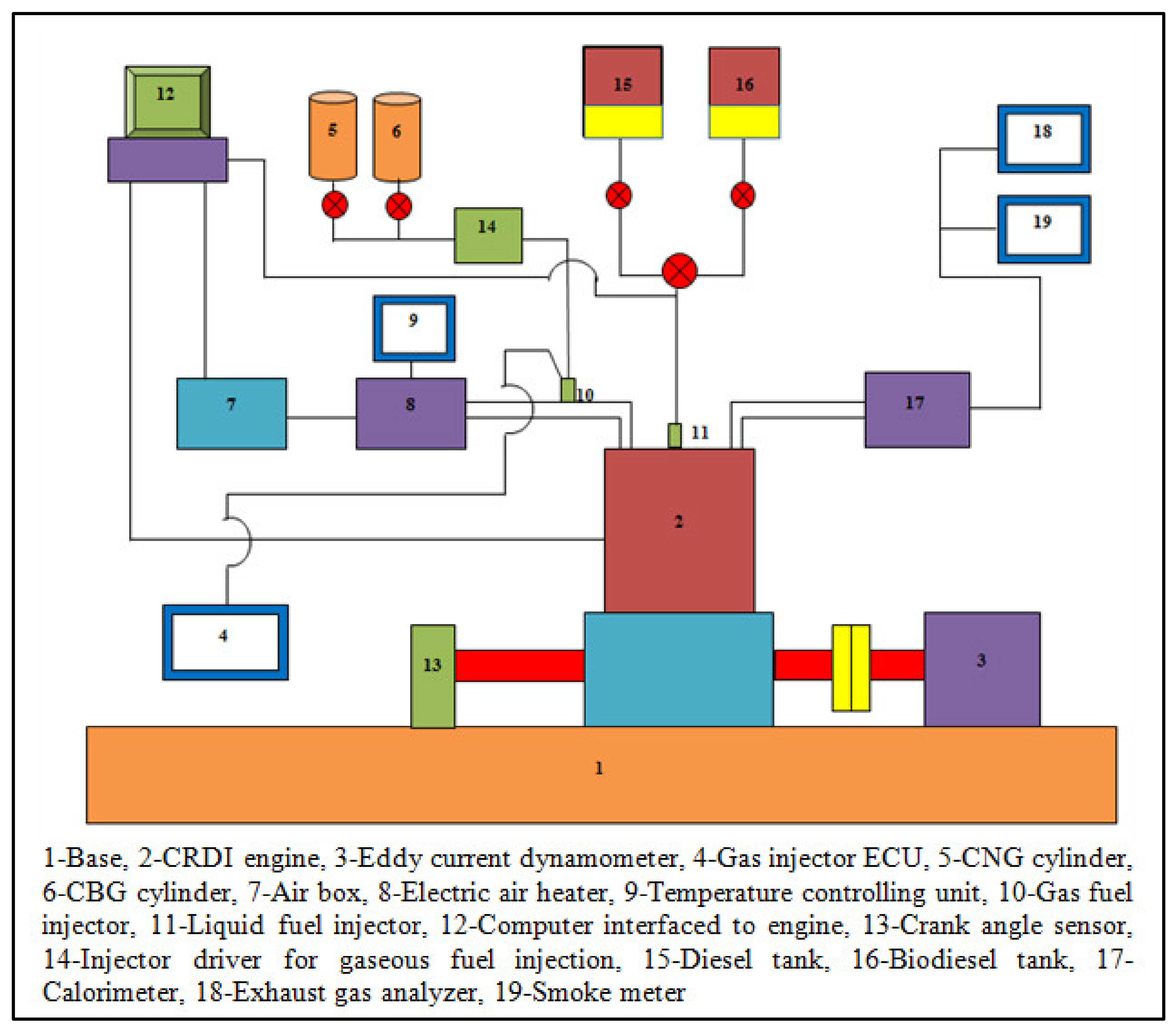

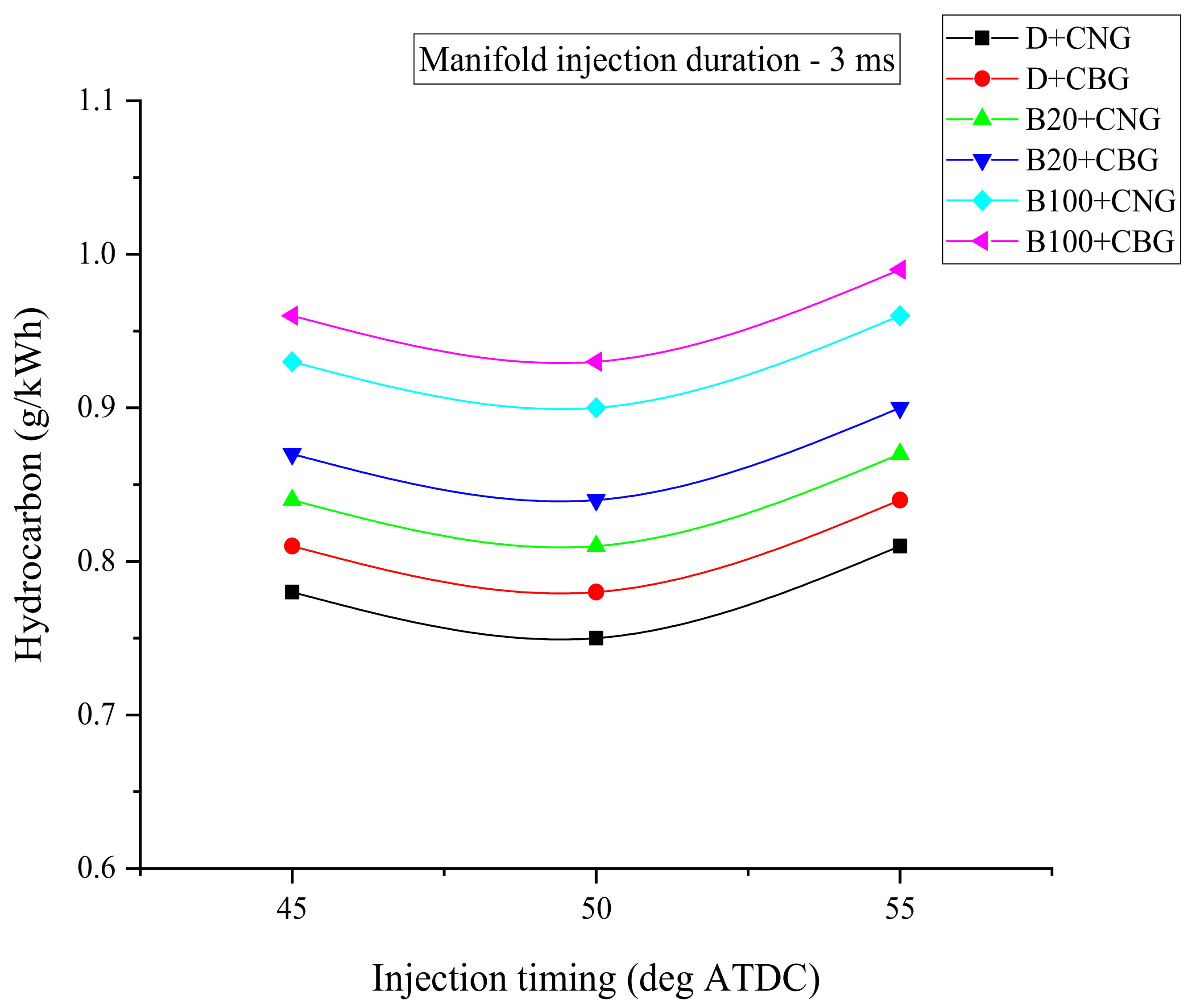



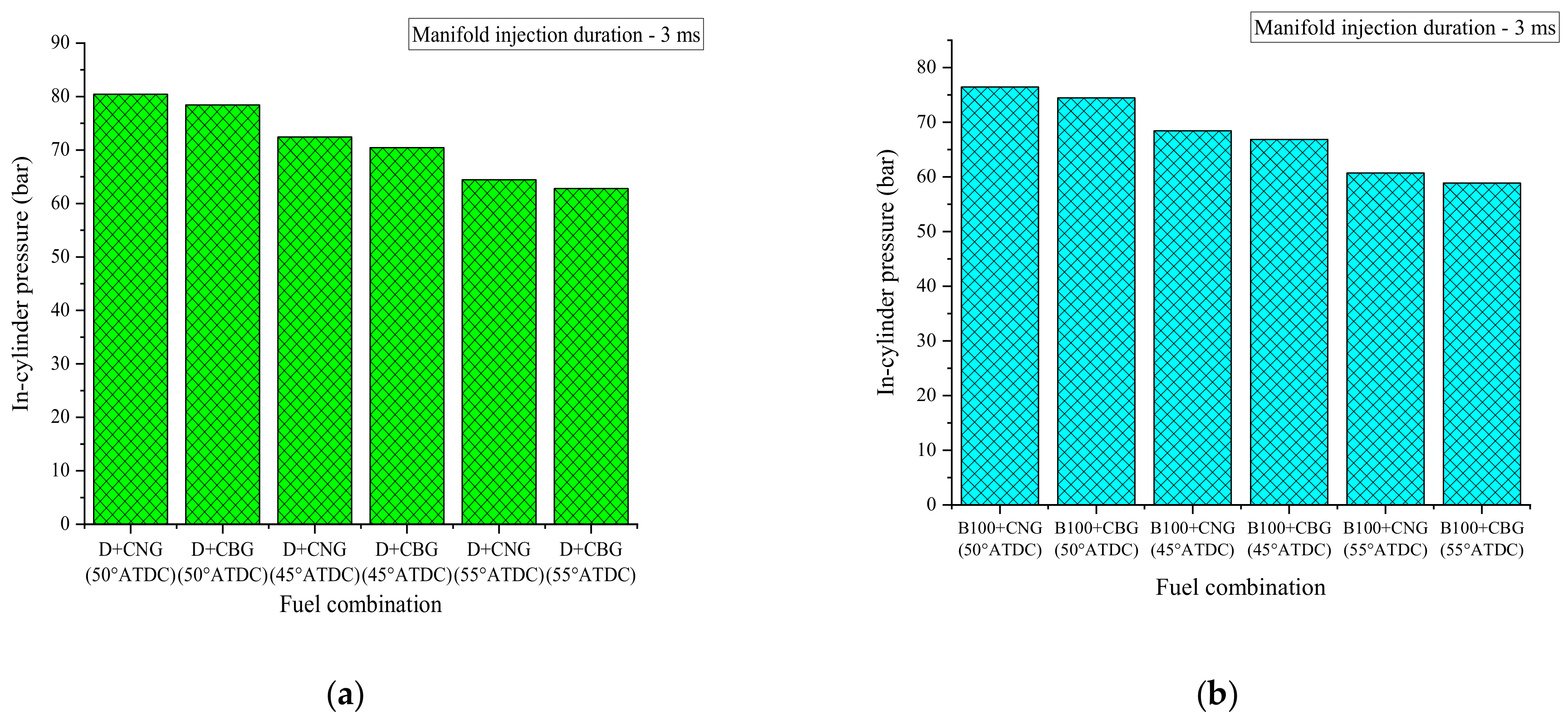
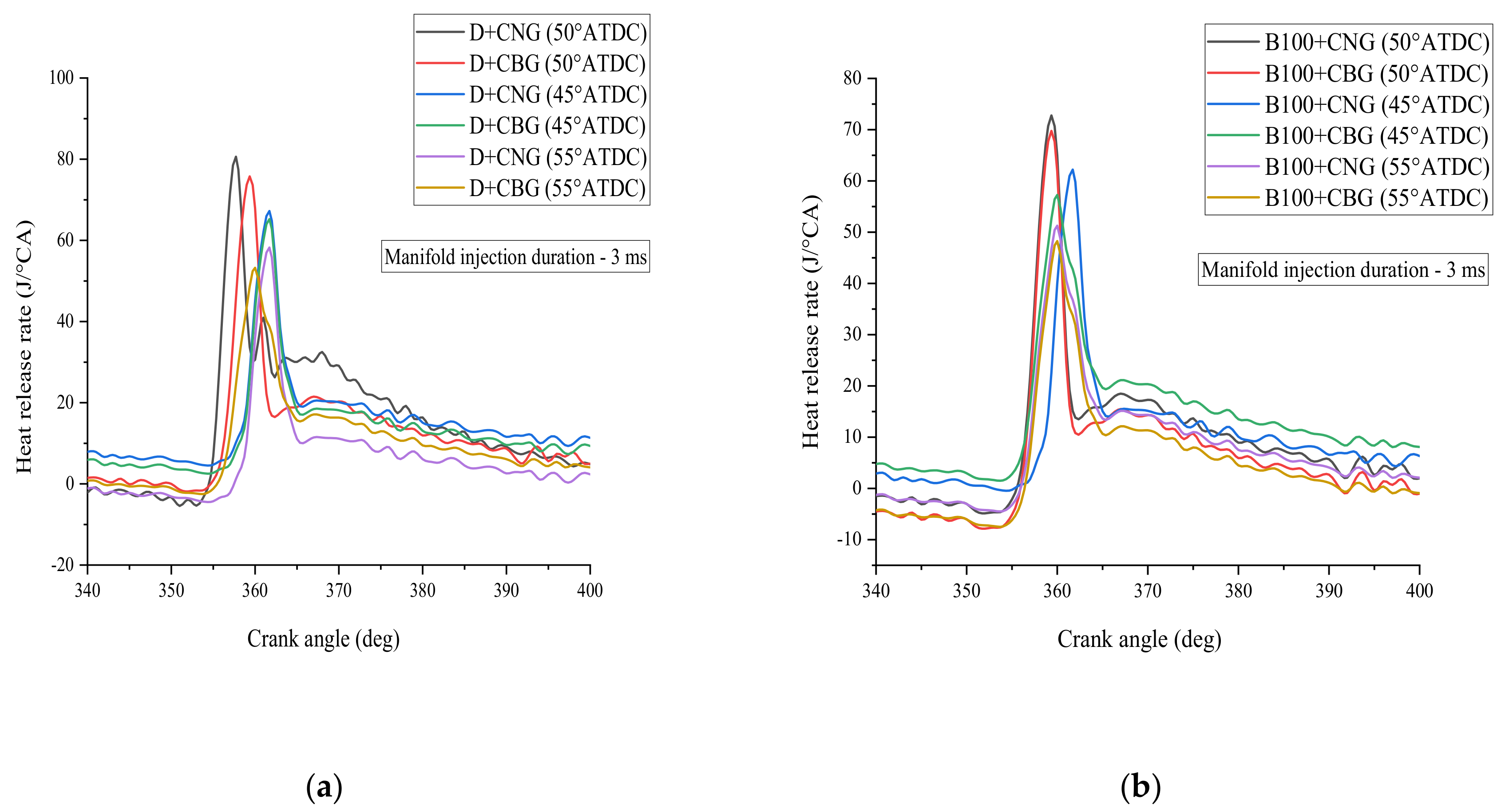
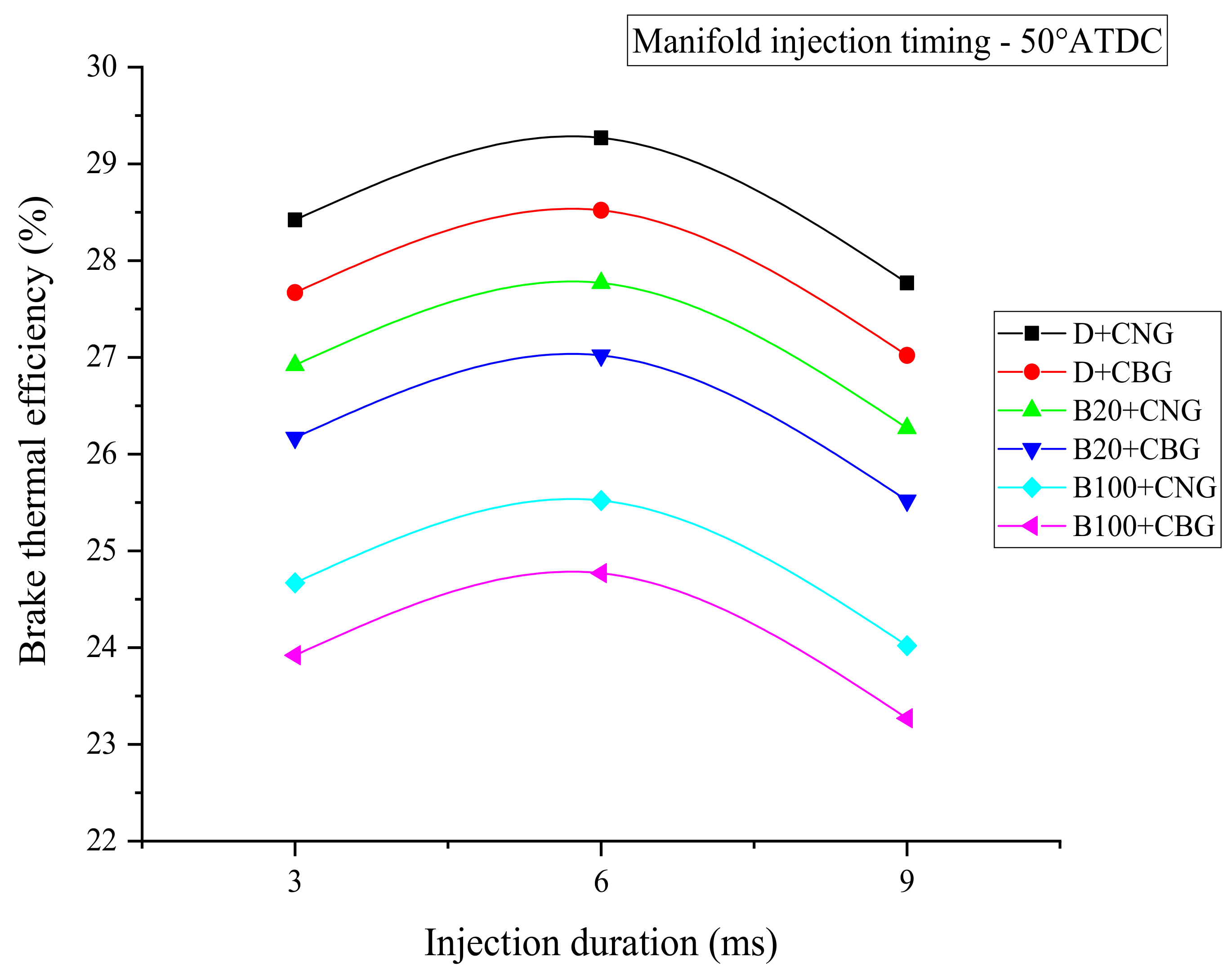

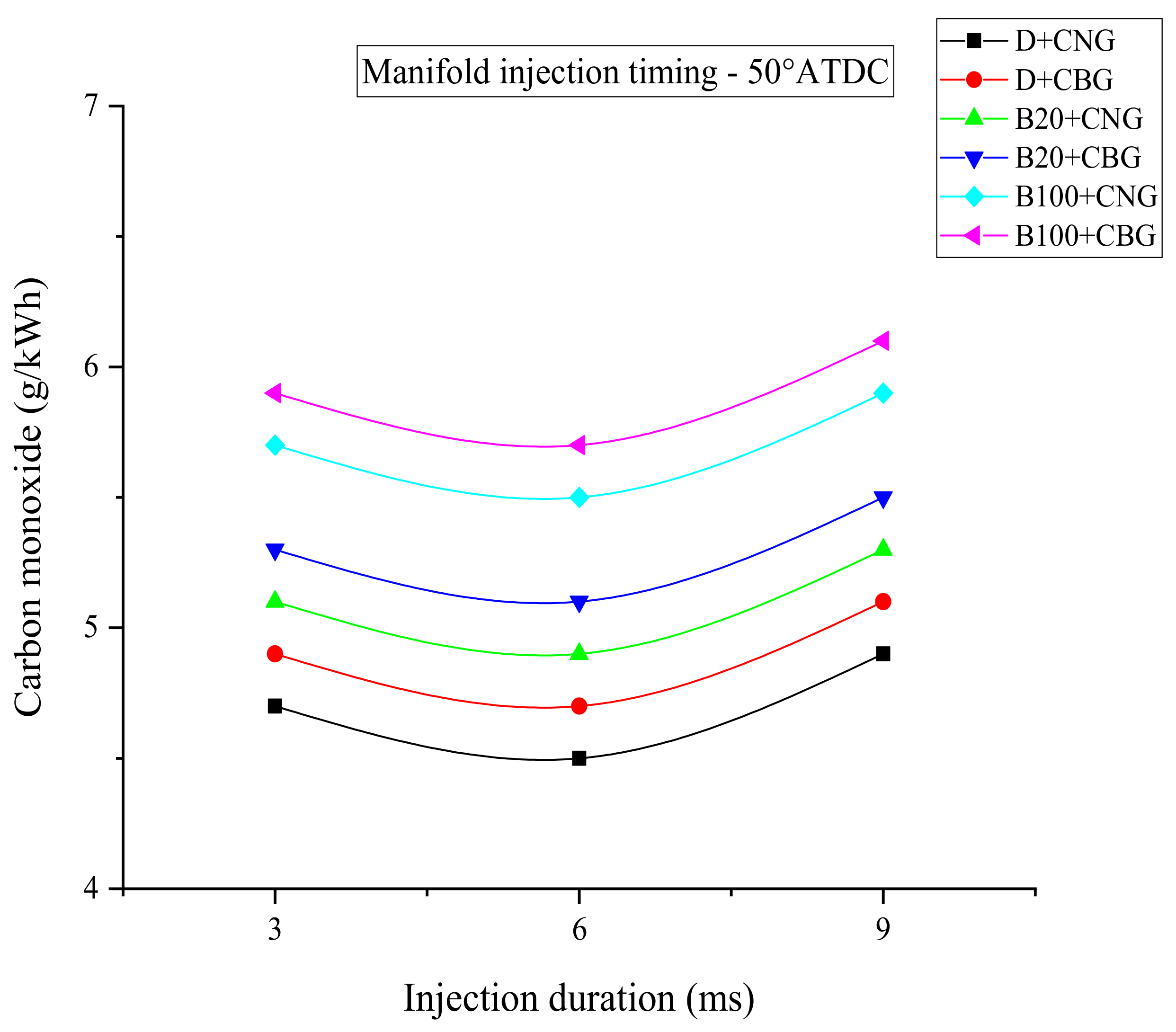

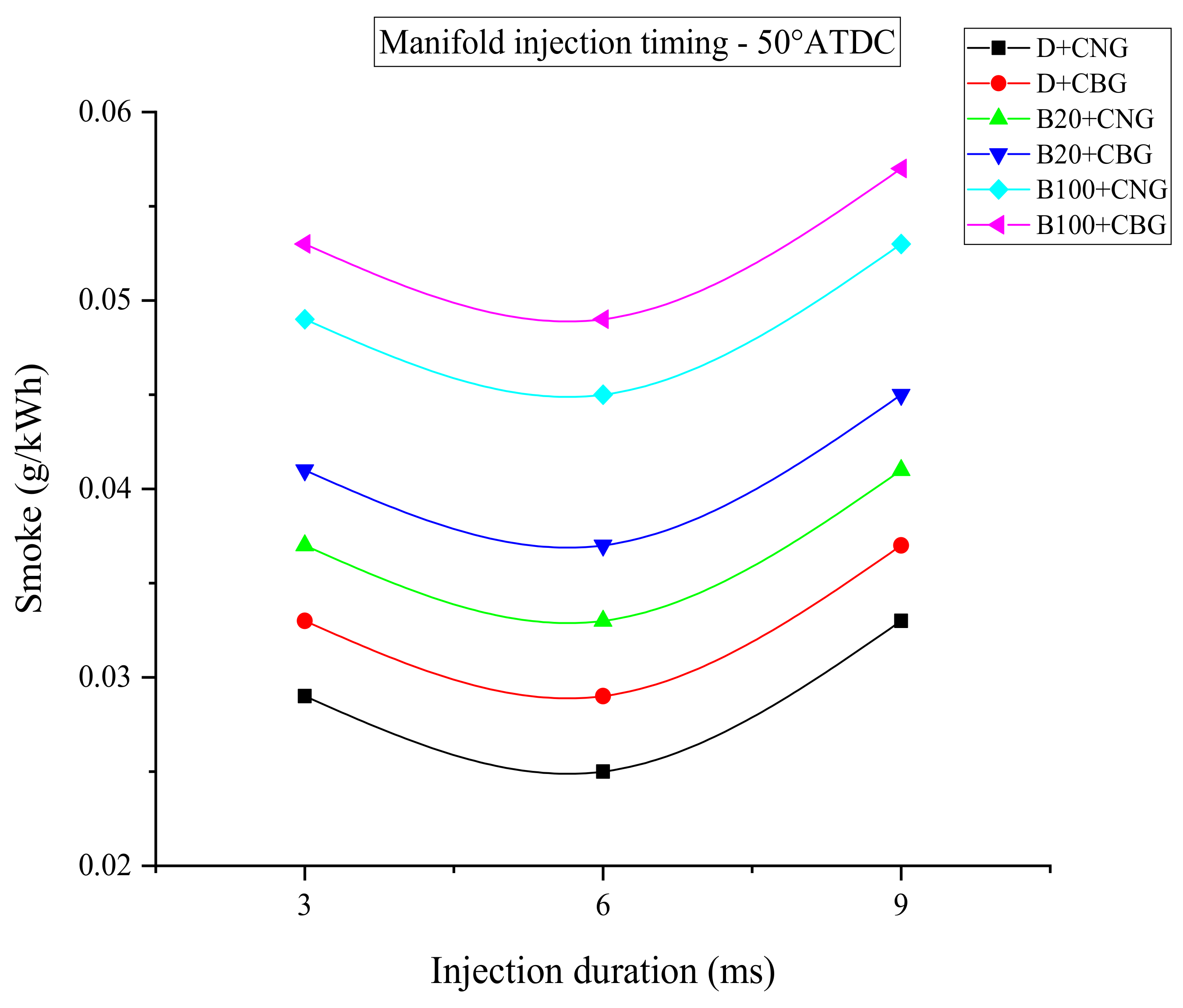


| Fuels/Properties | Diesel | TPME B20 | TPME B100 |
|---|---|---|---|
| Specific gravity | 0.829 | 0.839 | 0.892 |
| Kinematic viscosity (mm2/s) | 3.52 | 3.96 | 5.748 |
| Flash point (°C) | 53 | 77 | 178 |
| Calorific value (CV) (MJ/kg) | 42.19 | 41.45 | 39.46 |
| Properties | Natural Gas | Biogas |
|---|---|---|
| Cetane number | - | - |
| Octane number | >120 | 130 |
| Lower heating value (MJ/kg) | 50.0 | 19.1 |
| Auto-ignition temperature (°C) | 650 | 600–650 |
| Stoichiometric air–fuel ratio | 17.2 | 6.17 |
| Carbon content (%) | 75 | - |
| Flammability limits (vol.% in air) | 5–15 | 7.5–14 |
| Engine Parameters | Specifications |
|---|---|
| Engine | TV1 Kirloskar |
| Cylinders | 1 |
| Software | Engine soft |
| Strokes | 4 |
| Compression ratio | 17.5:1 |
| Cylinder bore (mm) | 87.5 |
| Stroke (mm) | 110 |
| Combustion chamber | Toroidal |
| Dynamometer | Eddy current |
| Engine rated power (kW) | 5.2 |
| Direct injection pressure (bar) | 900 |
| Manifold injection pressure (bar) | 5 |
| Type | Delta 1600S |
|---|---|
| Object of measurement | Carbon monoxide (CO) and hydrocarbons (HC) |
| Warm up time | 10 min (self-controlled) at 20 °C |
| Accuracy | ±2% relative |
| Speed of response time | Within 15 s for 90% response |
| Sampling | Directly sampled from tail pipe |
| Power source | 100–240 V AC/50 Hz |
| Weight | 800 g |
| Size | 100 mm × 210 mm × 50 mm |
| Type | Hartridge Smoke Meter |
|---|---|
| Object of measurement | Smoke |
| Measuring range opacity | 0–100% |
| Accuracy | ±2% relative |
| Resolution | 0.1% |
| Smoke length | 0.43 m |
| Ambient temperature range | −5 °C to +45 °C |
| Warm up time | 10 min (self-controlled) at 20 °C |
| Speed of response time | Within 15 s for 90% response |
| Sampling | Directly sampled from tail pipe |
| Power supply | 100–240 V AC/50 HZ 10–16 V DC @15 amps |
| Size | 100 mm × 210 mm × 50 mm |
Publisher’s Note: MDPI stays neutral with regard to jurisdictional claims in published maps and institutional affiliations. |
© 2021 by the authors. Licensee MDPI, Basel, Switzerland. This article is an open access article distributed under the terms and conditions of the Creative Commons Attribution (CC BY) license (https://creativecommons.org/licenses/by/4.0/).
Share and Cite
Harari, P.A.; Banapurmath, N.R.; Yaliwal, V.S.; Khan, T.M.Y.; Badruddin, I.A.; Kamangar, S.; Mahlia, T.M.I. Effect of Injection Timing and Injection Duration of Manifold Injected Fuels in Reactivity Controlled Compression Ignition Engine Operated with Renewable Fuels. Energies 2021, 14, 4621. https://doi.org/10.3390/en14154621
Harari PA, Banapurmath NR, Yaliwal VS, Khan TMY, Badruddin IA, Kamangar S, Mahlia TMI. Effect of Injection Timing and Injection Duration of Manifold Injected Fuels in Reactivity Controlled Compression Ignition Engine Operated with Renewable Fuels. Energies. 2021; 14(15):4621. https://doi.org/10.3390/en14154621
Chicago/Turabian StyleHarari, P. A., N. R. Banapurmath, V. S. Yaliwal, T. M. Yunus Khan, Irfan Anjum Badruddin, Sarfaraz Kamangar, and Teuku Meurah Indra Mahlia. 2021. "Effect of Injection Timing and Injection Duration of Manifold Injected Fuels in Reactivity Controlled Compression Ignition Engine Operated with Renewable Fuels" Energies 14, no. 15: 4621. https://doi.org/10.3390/en14154621









